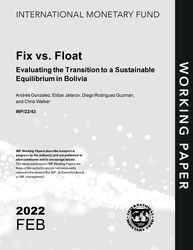
Fix vs. Float: Evaluating the Transition to a Sustainable Equilibrium in Bolivia
Fix vs. Float: Evaluating the Transition to a Sustainable Equilibrium in Bolivia
READ MORE...
Volume/Issue:
Volume 2022
Issue 043
Publication date: February 2022
ISBN: 9798400203053
$5.00
Add to Cart by clicking price of the language and format you'd like to purchase
Available Languages and Formats
| English |
Prices in red indicate formats that are not yet available but are forthcoming.
Topics covered in this book
This title contains information about the following subjects.
Click on a subject if you would like to see other titles with the same subjects.
Economics- Macroeconomics , Public Finance , Economics / General , Bolivia , inflation target , fixed exchange rate , speculative attack , transition path , linear time iteration , time consistency , , commodity revenue , long-run sustainability , open economy , utility function , Exchange rate arrangements , Conventional peg , Floating exchange rates , Government debt management , Exchange rate flexibility
Summary
Bolivia has achieved noteworthy success over the past 15 years in raising incomes, reducing poverty, and maintaining macroeconomic stability by deploying commodity revenues to finance transfers, public investment, and state-led development, using an exchange rate peg as a policy anchor. However, with the end of the commodity boom in 2014, fiscal deficits have grown and reserves have fallen. One route to restoring long-run sustainability would be to combine fiscal consolidation with a switch to a floating exchange rate. However, a preference for maintaining the peg could be accommodated with adjustments elsewhere in the policy framework. Employing a detailed dynamic stochastic general equilibrium model of the Bolivian economy, this study assesses the long-run sustainability and relative benefits of alternative policy combinations, and calculates optimal adjustment paths for the transition from the present situation to the steady state. It concludes that continued adherence to a fixed-rate regime, while not optimal, is feasible, if supported by a larger fiscal effort.
Copyright © 2010 - 2025
Powered by:
AIDC



